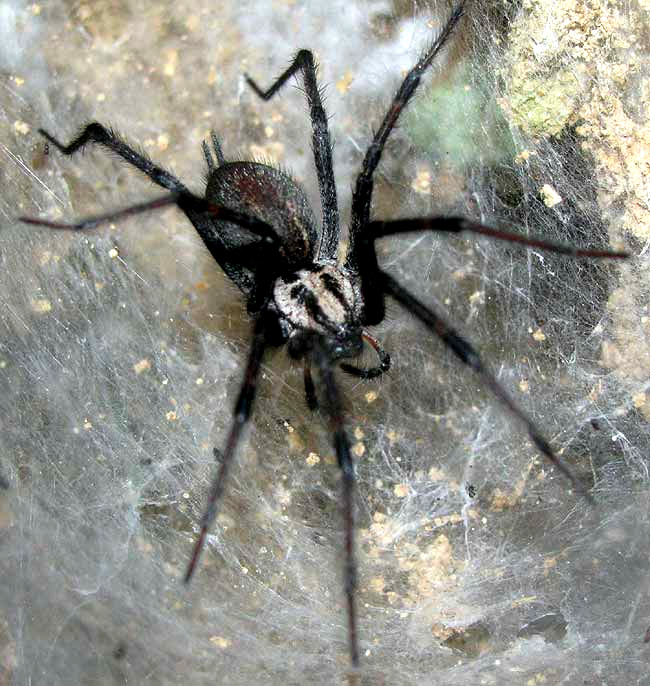Excerpts from Jim Conrad's
Naturalist Newsletter

from the August 26, 2012 Newsletter written at the woods edge in the Loess Hill Region a few miles east of Natchez, Mississippi, USA
GRASS SPIDER
Deep in the bottom of the steep-walled, shadowy ravine below my trailer a funnel web -- a flat sheet of silk about half a meter across (20 inches), at its far side warping into a cylindrical tunnel about wide enough to put a finger into -- formed a more or less horizontal sheet beneath overhanging tree roots. It was a dark, somber place and leaves and dirt from above cluttered the web, giving it a forlorn and unattended look. However, a big, black, motionless spider stood guard near the tunnel. You can see all this in a flash-illuminated photograph, with the spider in the top, left corner, below:

At the top of this page you see the spider, with two unusually long, silk-extruding spinnerets projecting from it rear end, and two distinct black, longitudinal lines crossing the white front body division, or cephalothorax.
The spider's body, not including the legs, was about 15mm long (9/16ths inch) so all spread out she was about 8cm long (3-¼ inches).
In my old Golden Nature Guide called A Guide to Spiders and Their Kin, the big spinnerets and the distinctive markings made it easy to figure out that this was a grass spider, genus Agelenopsis. However, our spider's rear body section, the abdomen, was much more rounded than those of Agelenopsis species illustrated in the book and on the Internet, plus no picture anywhere showed individual Agelenopsis spiders whose black cephalothorax lines were distinctly broken toward the back, like ours.
Happily, there's an active spider forum on the Internet where pictures of spiders are invited for identification, and several experts seem to be monitoring the forum full time. The forum is at https://spiderid.com/.
Within half an hour of my uploading our close-up, two folks had confirmed that it was indeed an Agelenopsis, and one suggested the species AGELENOPSIS NAEVIA, which I agree seems to be the most likely species. It was pointed out that abdomens on this species can be spherical like ours if it's a female full of eggs, or if it's just had a big meal.
However, pictures of Agelenopsis naevia don't show broken cephalothorax lines, so maybe we have a variation not represented on the Internet, or possibly even something new. By calling it Agelenopsis naevia here we make it easy for future experts working on the genus to find our picture and take it into consideration.
"Grass spider" is the general name for various species in the genus. Grass spiders are generally thought of as placing their funnel webs in grass or low bushes, so ours seems to have been a bit out of habitat. Grass Spider webs are not sticky like many webs, but the spiders themselves make up for this by being very fast runners. The moment something bumps into their web they race to the victim and pounce on it. Though grass spiders produce venom that paralyzes their prey, their fangs, or chelicerae, are too small to penetrate human skin, so grass spiders are harmless to people.